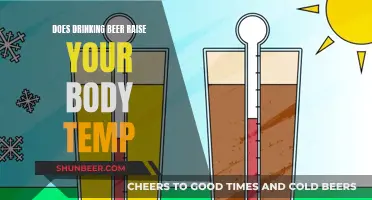
Drinking beer and getting ripped are not mutually exclusive. Alcohol does not stop muscle growth or fat loss, but it does hinder it. Beer contains empty calories and can amount to 153 calories per 12 oz. Alcohol also lowers the body's fat oxidation rate, reducing the amount of fat burned for energy. Beer consumption after a workout can blunt protein synthesis, making it harder for muscles to grow. However, drinking in moderation, choosing drinks wisely, and balancing calories can help mitigate these negative effects.
What You'll Learn

Alcohol is calorically dense and can hinder fat metabolism
Alcohol is highly calorific, with seven calories per gram, which is more than protein and carbohydrates, and it is processed differently by the body. Alcohol is not an essential nutrient and is treated as a toxin by the body, which works to remove it.
Alcohol is calorically dense, and a single 12oz beer can contain 153 calories, while a light beer of the same size has 103 calories. A 5oz glass of red wine has 125 calories, and a 1.5oz serving of liquor has 97 calories. These empty calories can quickly add up, and it is easy to exceed your daily calorie limit.
The calorific content of alcohol is not the only issue. Alcohol also negatively impacts fat metabolism. A study found that two drinks of vodka and sugar-free lemonade reduced lipid oxidation by 73%. Lipid oxidation is a measure of how much fat the body is burning, and alcohol severely reduces this. Alcohol is converted to a substance called acetate, and this sharp rise in acetate levels inhibits fat loss.
In addition to hindering fat loss, alcohol can also increase appetite and make you want to eat more. A study found that a group of men ate more food when their meal was accompanied by beer or wine compared to a soft drink. This effect, known as the "drunchies" or "drunk munchies," can lead to overeating and further impact weight loss goals.
While alcohol can hinder fat loss, it is important to note that moderate alcohol consumption as part of a balanced diet is possible without negatively affecting your fitness goals. The key is to drink in moderation, be mindful of the calorie content of different alcoholic beverages, and structure your day accordingly.
Beer and CAD: What You Need to Know
You may want to see also

Alcohol lowers the body's fat oxidation rate
Alcohol consumption can hinder a person's fat metabolism and, therefore, their ability to get ripped. When ingested, the body identifies alcohol as a toxin and works to remove it from the body. This process slows down the body's ability to metabolise fat.
Alcohol is calorically dense, with seven calories per gram, and is processed differently from other macronutrients. When alcohol is consumed, the body treats it like a toxin and prioritises metabolising it over other substances. This means that alcohol can shut down fat-burning processes for up to 12 to 36 hours, depending on the individual and the amount of alcohol consumed.
A study published in the American Journal of College of Nutrition found that, when men were given two vodka and sugar-free lemonade drinks, their lipid oxidation dropped by 73%. Lipid oxidation is a measure of how much fat the body is burning. Even though the cocktails in question were only 90 calories each, they had a significant impact on the drinkers' fat-burning ability.
Another study found that alcohol consumption decreased AMP-activated protein kinase (AMPK) activity in ethanol-fed rodents. AMPK is a master regulator of metabolism that senses cellular stresses and increases the activity of the major energy-generating pathways. Inhibition of AMPK blocks fatty acid oxidation and promotes fatty acid synthesis.
Alcohol doesn't just stop fat metabolism in the liver; it can also cause the liver to create more cholesterol and fat. Alcohol metabolites make it more difficult for the body to access stored fat for energy.
Heavy drinking after exercise can also reduce muscle protein synthesis. Although the alcohol was consumed after 25 grams of protein, it still produced a suppressive effect. This shows that even the anabolic effect of protein cannot overpower excessive alcohol consumption.
Beer Consumption and Type 1 Diabetics: What's Safe?
You may want to see also

Alcohol is converted to acetate, reducing the amount of fat burned for energy
Alcohol is a dense source of calories, with seven calories per gram, and is processed differently from other macronutrients. When ingested, the body identifies alcohol as a toxin and works to remove it. This process can take up to 36 hours, during which the body's metabolic pathways are shut down, and fat burning is hindered.
Alcohol is converted to acetate, a substance that puts the brakes on fat loss. In a study, subjects had a blood acetate level two and a half times higher than normal after consuming alcohol. This sharp rise in acetate inhibits the body's ability to burn fat for energy.
The body prioritises the metabolism of alcohol over other nutrients, including lipids from fats. This means that when alcohol is present in the system, the body will use it as a primary source of fuel before turning to glucose or lipids. As a result, the excess glucose and lipids are stored as adipose tissue, or fat.
Alcohol also affects the liver, which plays a crucial role in metabolising fats, carbohydrates, and proteins. Excess alcohol consumption can lead to alcoholic fatty liver, which damages the liver and impairs its ability to metabolise and store nutrients properly. This disruption in energy storage can make it challenging to lose weight.
In summary, while alcohol consumption may not directly lead to fat accumulation, it reduces the body's ability to burn fat for energy. The conversion of alcohol to acetate inhibits fat loss, and the prioritisation of alcohol metabolism disrupts the normal processing of other nutrients, leading to increased fat storage.
Mixing Beer and Cough Syrup: What You Should Know
You may want to see also

Alcohol can stimulate appetite
There is also good evidence that alcohol makes us feel hungrier, but only once we start eating. In studies where participants were asked to rate their hunger throughout the experiment, researchers found increased hunger ratings once subjects had begun eating after drinking alcohol. In contrast, hunger ratings given before eating, but after ingesting alcohol, were not increased. So, it seems that alcohol doesn't increase hunger in general but rather increases hunger once eating has begun.
Alcohol can also reduce how satiated or full we feel after eating. A 2001 study found that alcohol inhibits the secretion of leptin, a hormone partially responsible for inhibiting hunger and making us feel full. On the other hand, a 2005 study found that alcohol decreased the amount of ghrelin, the "hunger hormone", in the blood.
Alcohol is calorically dense, with seven calories per gram, and is processed differently from other macronutrients. Alcohol is not an essential nutrient, and when ingested, your body identifies alcohol as a toxin and works to remove it. Alcohol also severely lowers the body's fat oxidation rate. A study published in the American Journal of College of Nutrition found that when men were given two drinks of vodka and sugar-free lemonade, their lipid oxidation dropped by 73 per cent. Lipid oxidation is a measure of how much fat your body is burning. Rather than getting stored as fat, alcohol is converted to a substance called acetate.
Alcohol can also make you want to eat more. According to a study reported in the International Journal of Obesity and Related Metabolic Disorders, a group of men ate more food when the meal was served with beer or wine rather than a soft drink.
Beer and Kidney Health: What's the Connection?
You may want to see also

Drinking in moderation won't hinder muscle growth or fat loss
To drink in moderation and maintain your fitness goals, consider the following tips:
- Save up on a calorie buffer by reducing your intake of fat and carbohydrates earlier in the day. This will create room for the alcohol calories later without exceeding your daily limit.
- Avoid alcohol sources that are rich in carbohydrates, such as beer or drinks with fruit juices and sugary sodas. Instead, opt for dry wines, whiskey, vodka, tequila, scotch, gin, or cognac, which have zero or low carbs.
- Drink in moderation and avoid getting excessively drunk. This will help maintain your judgment and prevent overeating or making unhealthy food choices.
- Avoid eating late at night after drinking, as it can lead to additional calorie intake and weight gain.
- Be mindful of your reasons for drinking. If you are using alcohol to mask insecurities or escape reality, it may be detrimental to your health and fitness goals.
By following these guidelines, you can enjoy alcohol in moderation while still working towards your fitness and muscle-building goals.
Beer and Ulcers: What You Need to Know
You may want to see also
Frequently asked questions
Yes, you can drink beer and still get ripped, but only if you do it in moderation and as part of a balanced diet.
Drinking in moderation means limiting your drinking to one night a week or having 1 to 3 drinks when you go out.
Yes, choose your drinks wisely. Avoid drinks that are high in sugar and rich in carbohydrates. Also, balance your calories by cutting down on carbs and fat before your drinking session to make room for the alcoholic calories.
Yes, heavy drinking after exercise can reduce muscle protein synthesis and hinder fat metabolism. Excessive drinking can also lead to liver cirrhosis and negatively impact your health and appearance.







